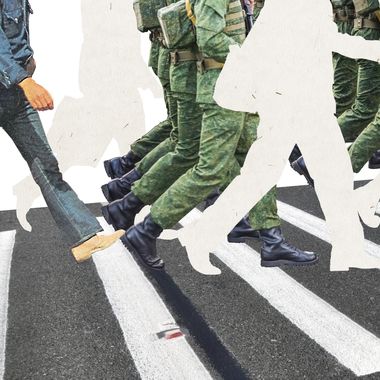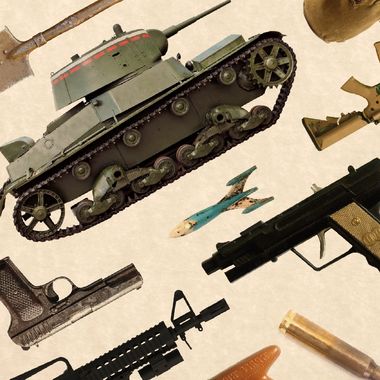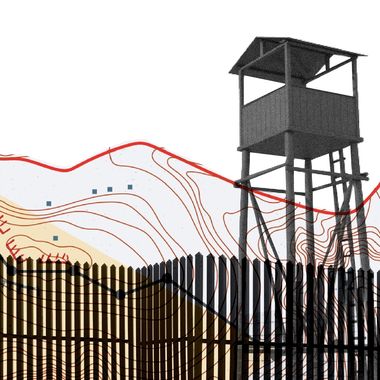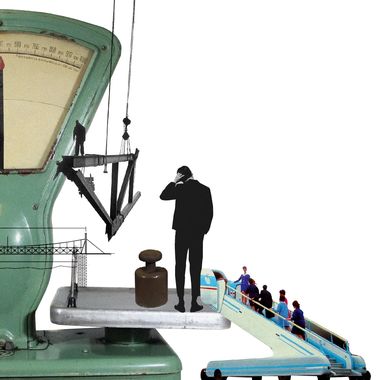Thu Mar 04 2021 · 10 min read
Russia’s Increasing Military Presence in Armenia

By Hovhannes Nazaretyan
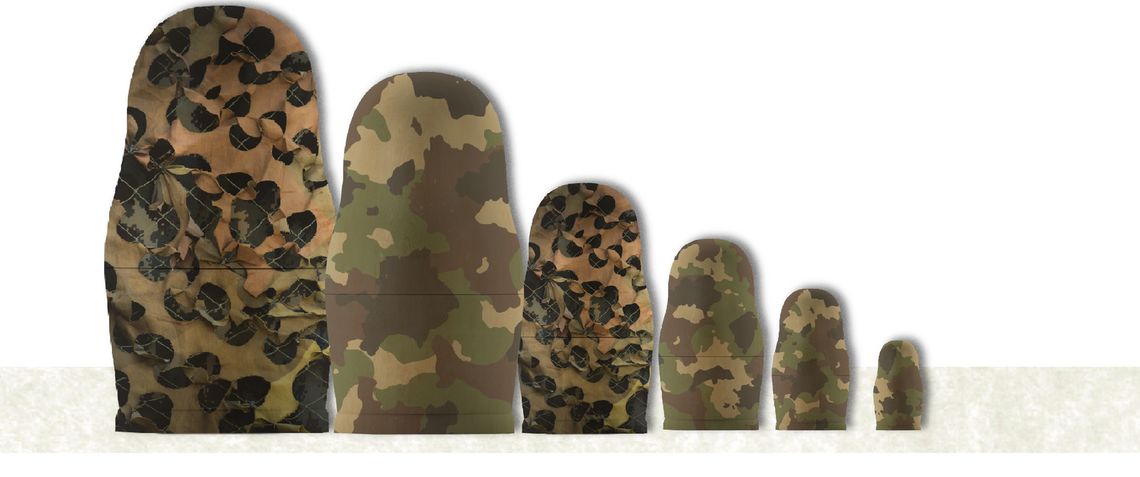
Illustration by Armine Shahbazyan.
Russia first established its military presence in Armenia in the early 19th century. Since what is now the Republic of Armenia became part of the Russian Empire in 1828, there has been a continuous Russian military presence in these lands, except for a brief period of disengagement in 1918-1920 in the aftermath of the 1917 Bolshevik Revolution. After the Soviet Union collapsed, Armenia did not force out Russian troops, unlike many of the other post-Soviet states, and established friendly and allied relations with Russia. The current Russian military presence in Armenia is largely associated with the base in Gyumri, but this view is superficial and does not represent the reality on the ground, especially with the significant increase in the aftermath of the 2020 Artsakh War.
When Armenia declared its independence from the Soviet Union in 1991, there was still a large contingent of Soviet troops in the country. According to the 1994 Yearbook of the Stockholm International Peace Research Institute (SIPRI), there were 23,000 Russian troops stationed in Armenia in mid-1992. This figure dropped to 5,000 by mid-1993, but then increased to 9,000 by the end of 1993.
Border Guards
On August 21, 1992, Russia and Armenia signed the “Treaty On the Legal Status of the Armed Forces of the Russian Federation Located on the Territory of the Republic of Armenia” which created the legal basis for the Russian military presence in the country. Article 4 stated that the Russian military stationed in Armenia is meant to safeguard the security of Armenia “along the external border of the former USSR.”
On September 30, 1992, the governments of Armenia and Russia signed the "Treaty on the Status and Conditions of the Activity of the Border Guard Troops of the Russian Federation in the Territory of the Republic of Armenia.” The Russian border guards were already deployed when the treaty was signed; it merely regulated their presence. It established that Russian guards were to protect the borders of Armenia with Turkey and Iran, i.e. the “external borders” of the former Soviet Union. Armenia’s borders with Georgia and Azerbaijan were out of scope.
The Russian border guard troops are under the command of the Border Guard Directorate of Russia’s Federal Security Service (FSB). As noted, under the 1992 treaty, they protect Armenia’s borders with Turkey, which is around 330 km long, and Iran, around 45 km long. This amounts to about one-fifth of Armenia’s total border length (around 375 km out of the total 1,730 km). The Russian border guards are also stationed at the air border checkpoint at Yerevan’s Zvartnots International Airport, where they serve jointly with Armenia’s Border Guards, a division of the National Security Service (NSS).
The Russian border guard contingent contains four detachments, stationed in Gyumri, Armavir, Artashat and Meghri, and a separate subunit at Zvartnots Airport. According to the Russian state-run RIA Novosti agency, there are around 4,500 Russian border guard troops stationed in Armenia. The administration of the FSB border guards in Armenia is located in Yerevan.
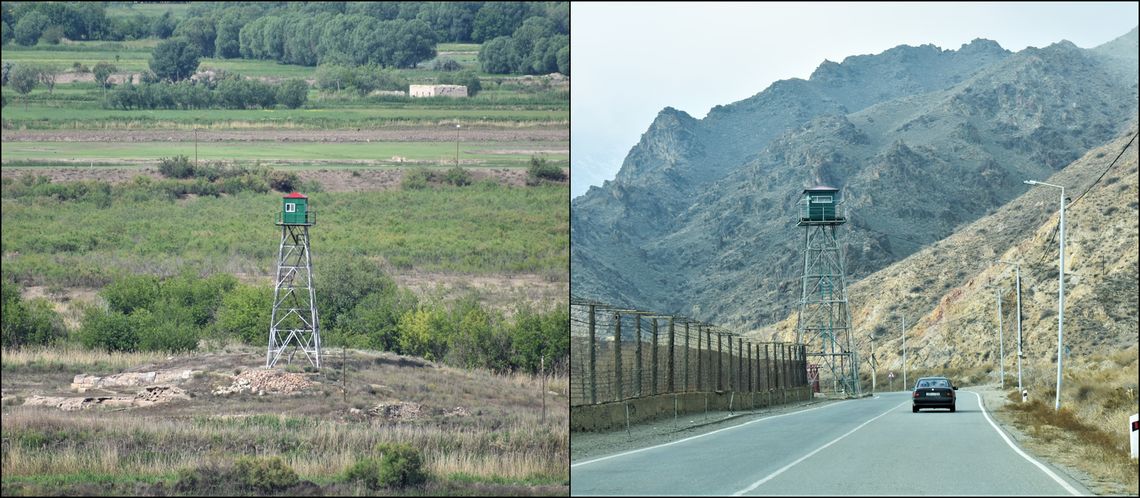
Watchtowers of the Russian border guards as seen from the monastery of Khor Virap, on the border with Turkey (left, May 2018), and near Meghri, on Armenia’s border with Iran (right, January 2021) (both photos by the author)
Russian Base in Gyumri
When the Soviet Union collapsed, the 127th Motor Rifle Regiment stationed in Gyumri was under the jurisdiction of the Transcaucasian Military District of the Russian Armed Forces. It was turned into the 102nd military base on June 21, 1994. The 3624th air base, stationed at Yerevan’s Erebuni military airport, joined the command of the base in May 1996.
The “Treaty Between the Russian Federation and the Republic of Armenia on the Russian Military Base on the Territory of the Republic of Armenia” was signed on March 16, 1995. Article 2 stated that Russian military formations stationed in Armenia will be transformed during that same year “into the Russian military base on the territory of the Republic of Armenia.” Article 26 stated that the treaty is valid for 25 years and is automatically extended for five-year periods if neither party notifies the other about their intention to terminate it. On August 20, 2010, presidents Serzh Sargsyan and Dmitry Medvedev signed an agreement extending the treaty for 49 years (calculated from 1995), i.e. until 2044. It was ratified by Armenia and Russia in April and June of 2011, respectively. The 102nd Russian military base, as it is now officially known, is now under the jurisdiction of Russia’s Southern Military District.
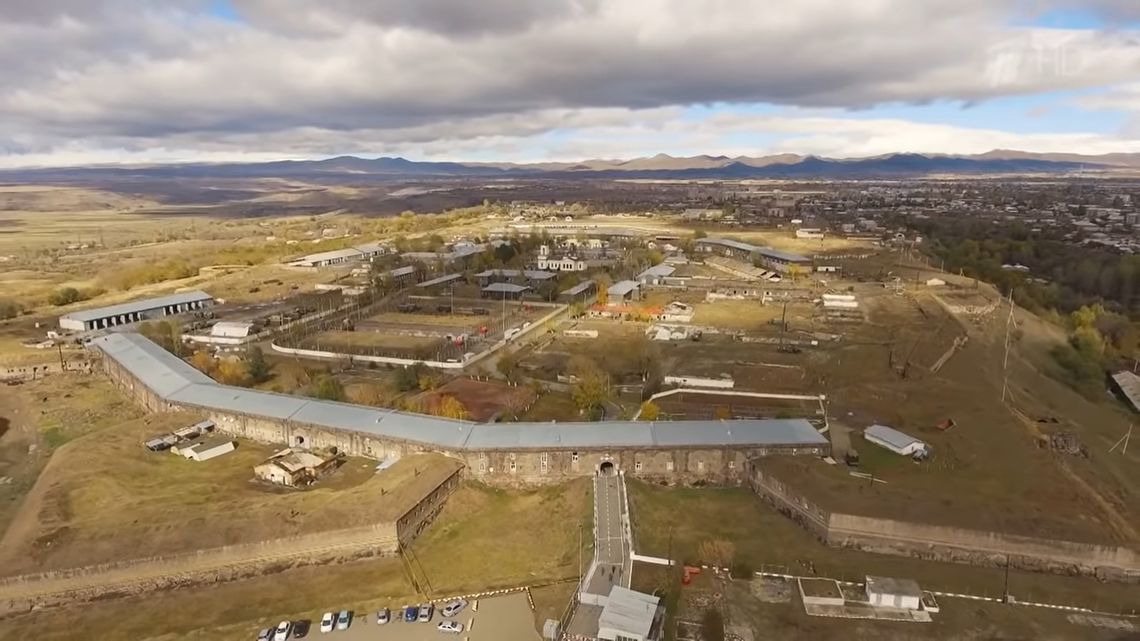
A garrison of the 102nd Russian base stationed in Gyumri’s 19th century Alexandropol Fortress (still from a 2019 video by Russia’s First Channel)
The exact size of the Russian military personnel of the 102nd base is estimated to be between a low of 3,300 (according to The Military Balance 2020, published by the International Institute for Strategic Studies) and a high of 5,000. In December 2013, Colonel Andrey Ruzinsky, the commander of the base, told the Russian Defense Ministry’s newspaper Krasnaya Zvezda that the base houses 4,000 troops.
Article 1 of the Third Protocol of the 1995 treaty sets limits on the quantity of armaments and equipment that can be deployed at the base, based on the Treaty on Conventional Armed Forces in Europe. It limits the number of tanks at 80, armored vehicles at 160 (including 75 infantry fighting vehicles, IFVs), and artillery pieces of 100 mm or larger caliber at 85.
According to Colonel Ruzinsky, as of 2013, the base housed BMP-2 infantry fighting vehicles (IFVs), T-72B tanks, Buk-M1-2 and Strela-10 surface-to-air missile systems, Smerch multiple rocket launchers, Gvozdika self-propelled howitzers, S-300 air defense systems and MiG-29 fighter jets. By early 2020, the base had reportedly added the Iskander ballistic missiles to its arsenal, according to Alexander Khramchikhin, Deputy Director of the Institute for Political and Military Analysis. In 2015, the base received Orlan-10 unmanned aerial vehicles (UAVs) in addition to the Navodchik-2 UAVs. The base also contains electronic warfare (EW) complexes since at least 2015. During the 2020 Artsakh War, there were unconfirmed reports that Krasukha EW systems were supposedly deployed at the base and downed Turkish Bayraktar TB2 UAVs.
In October 2019, Colonel Nikolai Martynyuk, commander of the base, reported to Russian Defense Minister Sergei Shoigu that the “combat potential" of the base “will almost double after rearmament with new and modernized models of weapons and military equipment.” Two months later, Sergey Kopyrkin, the Russian Ambassador to Armenia, stated that “We have plans to double the combat potential of the base without increasing the number [of military personnel].”
Presence in Yerevan
The 102nd base has a significant presence in the capital as well. It is composed of a garrison, located in Yerevan’s northeast suburb of Kanaker, and the 3624th Russian airbase, stationed at the Erebuni military airport in the southwestern outskirts of the Yerevan Capital District. The airport also serves as the base for the helicopters and transport aircraft of Armenia’s Air Force.
In 2015, Russia supplied seven modern helicopters, including Mi-24 attack helicopters and Mi-8 transport helicopters to the Erebuni air base. A source within the Russian military told the state-run TASS news agency in April 2019 that Russia was planning to supply, in 2020-2021, 18 modern Su-30SM fighter jets to replace the aging MiG-29s. In early December 2020, following the armistice that ended the 2020 Artsakh War, Russian sources reported that the airbase was on combat duty, with its aircraft flying over the skies of Armenia around the clock.
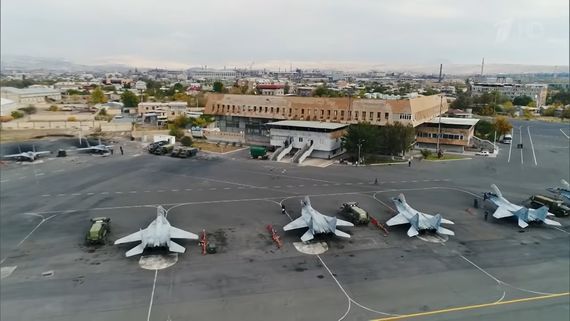
The Erebuni air base (still from a 2019 video by Russia’s First Channel)
Possible Expansion of the 102nd Military Base
On February 22, 2021, Armenian Defense Minister Vagharshak Harutyunyan told RIA Novosti about the possibility of “redeploying some military formation of the [102nd] Russian base to the eastern part of Armenia” and said that a “joint study of the issue is underway.” Though Harutyunyan did not specify its possible location, it could be deployed in the Vardenis area, southeast of Lake Sevan, an area that now has Azerbaijani troops nearby in the Kalbajar district, which was handed over by the Armenian side in accordance with the November 10 ceasefire agreement. The Sotk gold mine, located near Vardenis, straddles the border between Armenia and Azerbaijan and which had Azerbaijani troops enter it after the handover of Kelbajar, is run by GeoProMining Gold, owned by Russian billionaire Roman Trotsenko. Harutyunyan added that he does not see the need for the deployment of additional Russian military formations in Armenia.
Earlier, Edmon Marukyan, the leader of the parliamentary opposition Bright Armenia Party (BAP), had called for the establishment of a Russian base in the southern Syunik region to bolster the Russian peacekeeping contingent in Artsakh, guarantee peace and security in the region, and safeguard the border with Iran.
Military Police and Special Forces
On March 26, 2018, Russia’s Defense Ministry announced that Russian military police formations would be established at the Gyumri base and at the garrison in Yerevan. Though Artsrun Hovhannisyan, Armenia’s Defense Ministry spokesperson, said that the issue is being discussed and will be regulated by an agreement, Russian military police were already deployed to Gyumri and Yerevan by mid-March 2018 according to Alik Sargsyan, an MP from the Republican Party of Armenia (RPA) which was the ruling party at the time. On March 30, 2018, the opposition Armenian Times (Haykakan Zhamanak) newspaper posted a video of Russian military police officers walking in the streets of Gyumri. A little over a year later, in May 2019, Russia’s Defense Ministry noted in a statement that Russian military police officers are deployed in Gyumri and Yerevan.
On October 27, 1999, when five gunmen entered the parliament building in Yerevan and assassinated Prime Minister Vazgen Sargsyan, Parliament Speaker Karen Demirchyan and several others, a Russian anti-terrorist squad was “secretly flown [...] in preparation for an assault on the building.” According to Gagik Melkonyan, who served as Armenia’s Deputy Defense Minister (2000-2008), it included some 100 members of Alpha, the counter-terrorism special forces group of the FSB, who were stationed at the military police headquarters in Yerevan. Robert Kocharyan, Armenia’s president at the time, wrote in his memoirs that Alpha was sent to Armenia on the orders of Russian president Boris Yeltsin and were stationed at the headquarters of the National Security Service (NSS). According to the spokesperson of the FSB, Alpha arrived in Armenia at the request of the Armenian government. Another anti-terrorism unit reportedly arrived in Yerevan on the morning of October 28. Neither group partook in the operations.
In July 2016, when the radical opposition Sasna Tsrer armed group seized a police station in Yerevan, the leader of the group, Varuzhan Avetisyan, claimed that Alpha was going to storm the base, but did not provide any evidence for his claim or that Alpha had been sent to Armenia.
The 2020 Artsakh War
In the latter phase of the 2020 Artsakh War, Russia established its military presence in at least two locations in the border areas with Azerbaijan. On October 23, a field camp of Russian troops near the village of Tegh, on the Goris-Lachin highway that connects Armenia with Artsakh, was photographed by at least two journalists. On October 31, Vagharshak Harutyunyan, Pashinyan’s Chief Advisor, told Armenia's Public TV that “Russian troops are currently stationed in the village of Tegh, on the Armenia-Karabakh border, and in Meghri, they have been reinforced.”
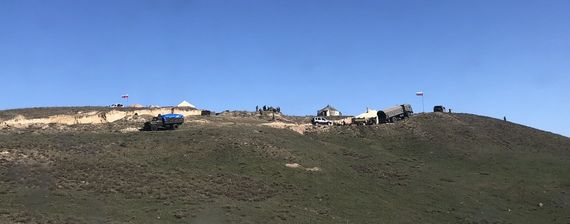
The Russian field camp near the village of Tegh, photographed by Amanda Coakley on October 23, 2020.
Another Russian military outpost was established in Yeraskh, near the border with Azerbaijan’s Nakhichevan region, no later than November 2. Joshua Kucera, the journalist who photographed the Yeraskh outpost, said he spotted another outpost near Tigranashen, not far from Yeraskh.
Post-War Expansion
On November 13, 2020, three days after the ceasefire, Alexander Bortnikov, the Director of Russia’s Federal Security Service (FSB), stated during a teleconference with Russian President Vladimir Putin and other high-ranking officials that Russian border guards would be deployed in five locations in Armenia, including at two locations on the border with Nakhichevan (Yeraskh and Paruyr Sevak), two on the border with Iran (Meghri and Sghrt), and one in the village of Tegh. A week later, on November 20, Bortnikov told Putin that Armenia had requested that Russia increase the size of the border guard personnel on its territory. Bortnikov said the FSB had deployed an additional 188 guards for deployment on the Armenia-Azerbaijan border.
On December 17, Melikset Poghosyan, the regional governor of Syunik, stated that Russian border guards, along with Armenian ones, are deployed at the villages of Vorotan and Shurnukh. Two days later, on December 19, Armenia’s Defense Ministry released a statement noting that Russian border guards are being deployed on a 21 km section of the Goris-Kapan highway.
By early January 2021, Russian border guards were stationed at a number of locations in Armenia’s Syunik province, where border delimitation has been ongoing since the armistice agreement. When I visited Syunik on January 4-6, I personally spotted a Russian presence at several locations on the Goris-Kapan highway that Azerbaijan has claimed to be within its territory, and also in Kapan and the Meghri area on the Armenia-Iran border. Two outposts were present on the almost 4 km long section of the highway between the villages of Karahunj and Vorotan that passes through the village of Eyvazli, which Azerbaijan also holds within its Soviet-era border.
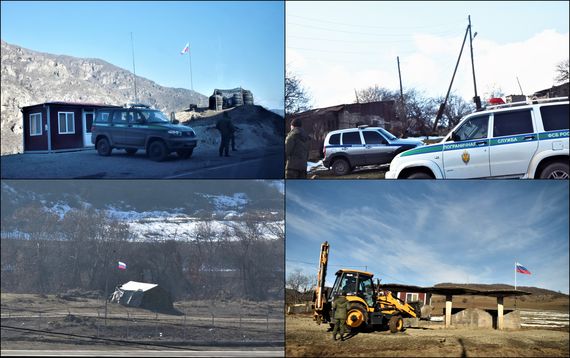
Russian border guards in Syunik on January 4 and 6, 2021. Top left: a Russian border guard outpost on the Goris-Vorotan highway, top right: Russian border guard vehicles in Shurnukh. Bottom left: a tent of the Russian border guards immediately outside the Kapan Airport, bottom right: the Russian flag raised on an abandoned bus stop near Karmakar (all photos by the author)
On January 4, Russian border guards were present in Shurnukh, while delimitation was ongoing within the territory of the village, which resulted in its partition into Armenian and Azerbaijani sections. Two days later, an Azerbaijani “welcome” sign was erected on the Azerbaijani side of the road. As a result of the controversial delimitation, a dozen houses came under Azerbaijani control.
In Kapan, Syunik’s regional capital, Russian border guards are stationed (since at least early January) near the newly-built airport, located immediately next to the newly-formed border with Azerbaijan that runs through the Voghji River. In mid-February, the regional administration of Syunik said that Russian border guards have established another outpost at the village of Agarak, near Kapan, after sporadic gunfire from the Azerbaijani side. As of mid-February, the Russian border guards patrol the entire highway from Vorotan to Srashen (which includes a large portion of the Goris-Kapan road) in their vehicles.
also read
On the Current Role of the Armed Forces and Civil Society in the Political Situation in Armenia
By Sossi Tatikyan
Armenia’s Constitution states that the Armed Forces must ensure the security, defense and territorial integrity of Armenia, as well as the inviolability of its borders. Intervention by the army in political processes is a violation of the principle of political neutrality and civilian control over them.
Arms Supplies to Armenia and Azerbaijan
By Hovhannes Nazaretyan
For nearly three decades, Armenia and Azerbaijan have been buying large quantities of weapons from a number of countries. Hovhannes Nazaretyan presents a comprehensive list of weapons acquired by both countries since independence.
Bayraktars Over Artsakh
By Hovhannes Nazaretyan
Armenia’s air defense systems were largely ineffective against the onslaught of combat and reconnaissance UAVs used by the Azerbaijani military. The single most important UAV used in the 2020 Artsakh War was the Turkish-made Bayraktar TB2.
Defeated Generals Demand the Resignation of a Defeated Prime Minister
By Nerses Kopalyan
The demand for the Prime Minister’s resignation by the Army’s General Staff is a violation of the civilian-military doctrine that has served as an institutional and normative standard within Armenia’s state system and establishes a highly dangerous precedent.
Armenia’s New Security Architecture: Russia as Geopolitical Bodyguard
By Nerses Kopalyan
Armenia needs to reconfigure the political economy of its security architecture by utilizing its security alliance with Russia, through a mechanism of burden-sharing, where Russia’s geopolitical interests are aligned with Armenia’s security interests.
Can Trade Prevent War?
By Artin DerSimonian
Given the growing sense of global multipolarity and the apparent twilight years of the American-anchored liberal international order, Armenia cannot solely rely on friends and allies around the globe to ensure its survival. A more realistic approach is necessary.

